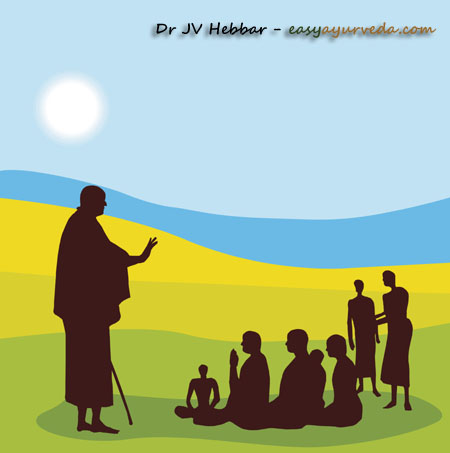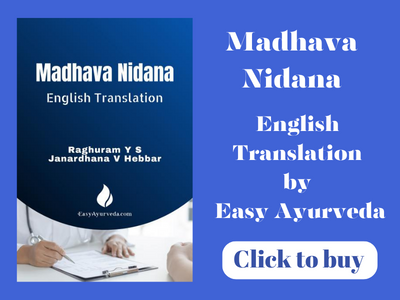Madhava Nidana Chapter 23 Vata Raktha Nidanam
This article explains Madhava nidana 23rd chapter “Vata Raktha Nidanam”. Causes, pathology and symptoms of Vata Raktha are explained in this chapter.
Read – Acharya Madhavakara: His Work ‘Madhava Nidana’, Legacy, Amazing Facts

Table of Contents
Vatarakta Nidana
Etiological Factors of Vatarakta
- Excessive indulgence in foods which are salty, sour, pungent, alkaline, unctuous (fatty), hot or uncooked (unprocessed),
- Excessive consumption of flesh of animals or birds belonging to marshy or desert like regions – which are either wet (soaked in water for long time) or dry (devoid of moisture)
- Excessive consumption of eatables having sesame paste, radish, horse gram, black gram, cow pea, green leafy vegetables, meat (mutton), sugarcane (juice),
- Excessive consumption of curds, fermented drinks like aranala, sauviraka, sukta, takra (fermented buttermilk), sura, asava etc
- Excessive consumption of incompatible (foods having opposite qualities),
- Eating food in excess
- Anger
- Habit of sleeping during day time and keeping awake at night (and many such other unhealthy foods and activities)
The above-mentioned etiological factors produce a disease called Vatarakta especially in those who are very tender (those people who are not accustomed to hardships of life, those having soft and tender organs or body parts), who are obese and people who are always happy and content (have not experienced hardships or misery of any kind.
Read – Vatarakta: Causes, Pathogenesis, Types, Treatment

Vatarakta Samprapti
Pathogenesis of Vatarakta
Excessive riding on elephants, horses, camels etc (animal back) for long durations of time or regularly (as a habit or part of profession) and excessive indulgence (consumption of) in foods which cause burning sensation (inside the body) during or after digestion etc. will burn the food which in turn would quickly burn (vitiate or contaminate) the blood.
This burnt and improperly processed blood will flow downwards and accumulate in the foot. Here this blood gets associated with vata which has been aggravated due to its etiological factors (like riding on the elephants etc. mentioned above) and causes the disease therein. Since vata is predominant in this disease it is called as Vatarakta. (1-4)
Vatarakta Purvarupa
Premonitory Symptoms of Vatarakta
Excessive or absence of perspiration, black discolouration, loss of tactile sensation,
severe pain even on slight injury (pain in the seat of injury), looseness of joints,
laziness (lethargy), debility, appearance of boils (eruptions, blisters) in joints of knee, leg, thigh (hip), pelvis (waist), shoulder (blade, axillary region), hands (fingers), feet (toes) and the entire body.
There will also be severe pain which present in different ways, like throbbing (gnawing), pulsating and cutting (in the above-mentioned joints and body) along with heaviness and loss of sensation. Apart from these, there is itching, the pain keeps coming and going in the joints (intermittent pain), discolouration and appearance of circular rashes. (5-7)
Read – Charaka Samhita Vatarakta Chikitsa 29th Chapter
Vatadhika Vatarakta
If vāta is very predominant in vatarakta, there will be excessive (severe) pain, like pulsating or tearing (cutting) pain. The swelling over the joints will appear dry, black or blue (bluish black). The symptoms increase or decrease often. There will be contractures of arteries (blood vessels) and joints of the fingers, stiffness of the body parts and severe pain. The person will have dislike (aversion) towards cold things and the symptoms would increase by consumption of or exposure to cold things, stiffness, tremors and loss of sensation etc (in other parts of the body). (8-9)
Raktadhika Vatarakta
If in vatarakta, rakta is affected profoundly; the swelling will be having severe pain, pricking or a feeling of pins and needles, coppery red in colour, and tingling sensation. There will be no relief with unctuous (oily) or dry comforts (like massage etc). The person will also have itching and exudation from the joints. (10)
Read – Classification Of Pain And Arthritis As Per Ayurveda
Pittadhika Vatarakta
If pitta is predominant (in vatarakta) the person would experience burning sensation in the body, delusion, perspiration, unconsciousness (fainting), intoxication and thirst. There will also be tenderness, pain, redness, swelling, suppuration (formation of pus) and increased heat (temperature). (11)
Kaphadhika Vatarakta
If kapha is predominant (in vatarakta), the person would feel as if his body has been wrapped with wet cloth and would experience heaviness of the body, loss of sensation, unctuousness (greasy feel), coldness, itching and mild pain (in the joints).
Dwandwa and Sannipataja Vatarakta
When there is predominance of two doshas in vatarakta, the symptoms of both doshas will be present mixed together.
When there is predominance of three doshas in vatarakta, the symptoms of all the three doshas will be present mixed together. (12)
Mode of spread of vatarakta
The (pain of) vatarakta usually starts from the root of the legs (toes or ankle joint) or from the root of the hands (fingers or wrist joint) and spreads to the other parts of the body, slowly, just like a rat poison. (13)
Read – Vata Dosha – Mastermind Behind All Body And Mind Activities
Symptoms of incurability

Vatarakta is said to be incurable if –
- It has started in the toe and has spread to the knee joint (all the joints from foot to knee are affected)
- The skin over the joints has peeled off or has cracked and if there is exudation from the cracked skin
- It is associated with many complications (like loss of sleep etc enumerated below) which bring about
- Destruction of muscles (muscular wasting) and loss of vital functions of the body (prana)
Read – Diseases Due To Pathological Muscle Tissue – Mamsa Pradoshaja Rogas
Vatarakta is said to be manageable (persists for the rest of the life but would require regular treatment to keep it under control – yapya) if it has not existed for more than one year.
Vatarakta associated with complications is also incurable.
The complications of vatarakta are –
loss of sleep, anorexia, dyspnoea (increased / difficult respiration),
putrefaction of muscles, headache, unconsciousness (fainting), intoxication,
pain (colic), thirst, fever, delusion, rigors (tremors), hiccough,
lameness (inability to walk), herpes / erysipelas (or other skin diseases),
suppuration, pricking sensation (pain), giddiness, exhaustion (tiredness),
crookedness / contractures of fingers (or toes), blisters, burning sensation,
diseases / pain in the vital organs and appearance of tumours (nodules).
The patient of vatarakta having these complications shall be refused treatment. Vatarakta is incurable even if unconsciousness is the only complication associated with it.
Read – Gout: Causes, Symptoms, Treatment, Home remedies
When vatarakta is not associated with all the above-mentioned complications (only few complications exist), the condition is said to be manageable (disease would persist for life but would require regular treatment).
When vatarakta is devoid of any of the above-mentioned complications it is said to be curable.
Vatarakta is caused by only one dosha and that which is of recent onset is curable.
Vatarakta caused by two doshas is manageable (persists for life but needs regular treatment).
Vatarakta caused by all three aggravated doshas is incurable. Similarly, vatarakta associated with complications is also incurable. (14-18)
Thus ends the chapter on Vātarakta Nidanam in Madhava Nidana text written by Acharya Madhavakara.











